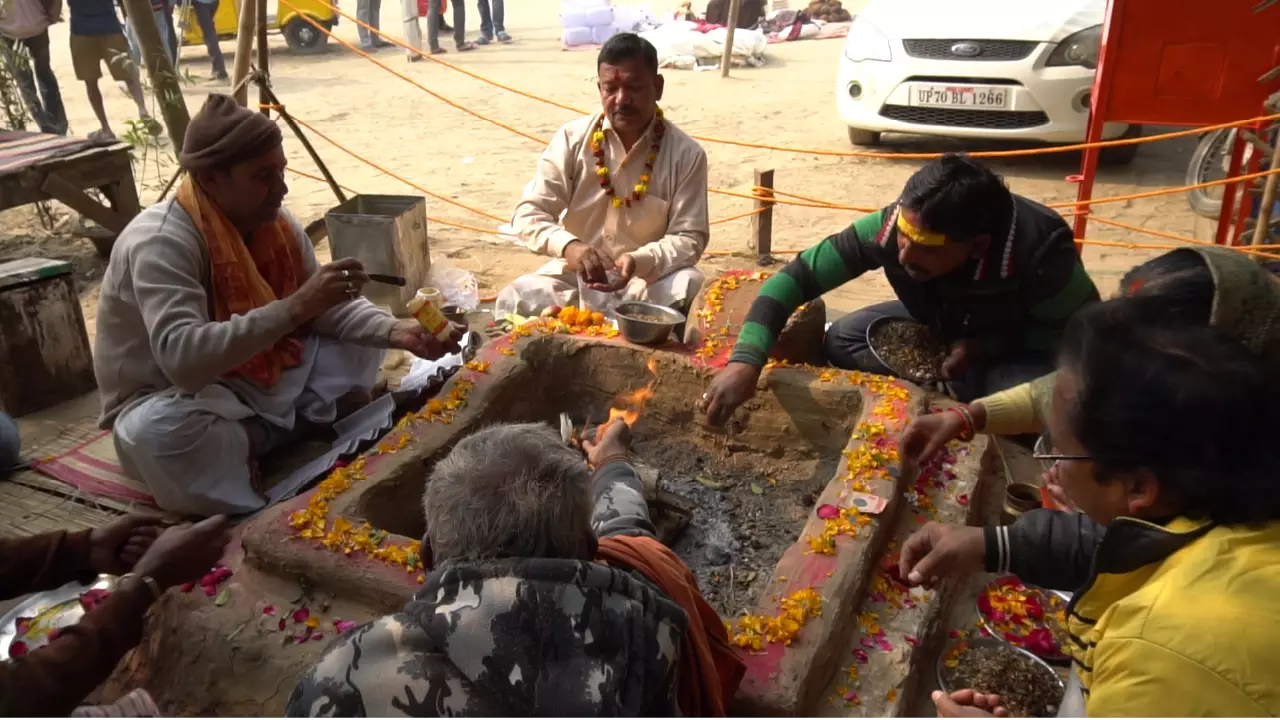What is a “Shahi Snan”? A Guide to the Royal Bath of the Akharas
The Kumbh Mela Shahi Snan stands as the sacred heart of the world’s largest spiritual gathering—a celestial moment when earth, water, and cosmic energy merge into one. For the saints and pilgrims who have come guided by faith, the Shahi Snan is not just a ritual bath; it is the eternal dance of devotion, discipline, and divine timing. At the break of dawn, under astrological alignments foreseen in ancient Vedic texts, the Akharas march in royal splendor toward the riverbanks, where one sacred dip symbolizes centuries of spiritual heritage.
The Divine Timing: Vedic and Astrological Foundations
The Kumbh Mela Shahi Snan is no arbitrary affair. Its timing is ordained by cosmic rhythms described in the Vedas and Puranas, refined through Jyotish Shastra — the science of astrology. According to this ancient wisdom, the movement of Jupiter (Brihaspati), the Sun (Surya), and the Moon (Chandra) determine when the celestial energies reach their climax, empowering the sacred waters with purifying vibrations.
The Power of Kumbha Yoga
During what is known as the Kumbha Yoga, a rare planetary alignment occurs that magnifies the spiritual potency of the river waters a thousandfold. Bathing on these days is said to be equivalent to performing countless yajnas (sacrifices). The Padma Purana describes these alignments as moments when the gods themselves descend to witness humankind’s devotion.
Auspicious Dates of Shahi Snan
The most revered days for bathing during the Kumbh Mela Shahi Snan include Makar Sankranti, Mauni Amavasya, and Vasant Panchami. Each day carries a symbolic resonance—from the awakening of the Sun’s northern journey to the silence of inner reflection and the blossoming of spiritual renewal. On these days, millions gather along the ghats, waiting for their moment to merge with the cosmic flow.

The Royal Ascetics: The Sovereignty of the Akharas
The word ‘Shahi’, meaning royal, reflects the exalted status of the Akhara saints. These monastic institutions are the spiritual guardians of the Vedic tradition. Established centuries ago by Adi Shankaracharya, they have preserved the disciplines of yoga, philosophy, and self-defense that sustain Sanatan Dharma.
Hierarchy Among the Akharas
There are 13 prominent Akharas in total, including Juna, Niranjani, Mahanirvani, and Anand Akhara. Each carries its distinct spiritual lineage and practices. The heads of these Akharas, called Mahamandaleshwars, are honored as the sovereigns of the Kumbh Mela Shahi Snan. Their blessings are sought by millions who regard them as custodians of divine tradition.
The order in which they approach the river reflects centuries of reverence and protocol. The Juna and Niranjani Akharas traditionally lead, symbolizing the authority of the Shaiva sect, followed by the Vaishnava and Udasin Akharas. Pilgrims can enter the sacred river only after these ascetics complete their ceremonial bath.
The Majestic Procession: Peshwai and Its Splendor
If the Shahi Snan is the soul of the Kumbh Mela, the Peshwai is its spectacle. A grand procession announcing the arrival of the Akharas, the Peshwai fills the streets with devotion, color, and celestial grandeur.
The Path of the Saints
Before dawn, the Akharas begin their procession, moving gracefully toward the ghats. Elephants and horses draped in vibrant fabrics lead the way. The sound of drums, conch shells, and bells merges with chants of Har Har Mahadev and Jai Ganga Maiya, creating an atmosphere charged with divine energy.
At the heart of the procession march the Naga Sadhus—naked ascetics smeared in sacred ash (bhasma)—symbols of renunciation and fearlessness. Their appearance often stuns first-time visitors, yet for those who understand, it is a living embodiment of the soul’s shedding of all worldly attachments. Their ash-covered bodies represent the cycle of birth and death—where all returns to dust and spirit remains unbound.
Symbolism in the Procession
Every trident, sword, and flag carried by the sadhus holds meaning. They signify the eternal fight against ignorance, illusion, and spiritual inertia. The Kumbh Mela Shahi Snan processions serve as an expression of unity within diversity, reminding all that the spiritual quest transcends sectarian boundaries.
The Sacred Immersion: The Bath that Transcends Worlds
When the first Akhara reaches the water’s edge, a profound silence sweeps through the crowd. The Ganga gleams under the rising sun, mirroring both heaven and earth. The moment the first ascetics enter the river, the entire space vibrates with chants and prayers.
Destruction of Sin and Liberation of the Soul
The scriptures explain that bathing during the Kumbh Mela Shahi Snan not only purifies one’s body and mind but also frees the soul from sins accumulated over countless lifetimes. The Skanda Purana assures that a sincere dip on this day can erase karmic debt, grant Moksha (liberation), and even benefit one’s ancestors. The waters, charged with astrological and spiritual energy, act as mediums of transformation—bridging the material and the divine.
The Spirit of Austerity
The saints exemplify tapas (austerity), enduring cold, hunger, and long rituals to express total surrender. For pilgrims, traveling vast distances and waiting for this sacred plunge also becomes an act of tapas. Each discomfort borne becomes part of the offering, transforming hardship into grace.

Beyond Ritual: The Inner Meaning of the Kumbh Mela Shahi Snan
To observe the Kumbh Mela Shahi Snan is to witness India’s living spirituality embodied in one moving, breathing ritual. The river represents the divine consciousness flowing through existence, while the act of bathing symbolizes surrendering the self into that cosmic current.
For the Akharas, it reaffirms their unity and ancient mandate to uphold Dharma. For ordinary devotees, it is a once-in-a-lifetime chance to dissolve individuality into the universe’s infinite embrace.
As one stands on the riverbank, surrounded by saffron flags waving and the sound of mantras drifting through the mist, it becomes clear—this sacred dip is a call from the eternal itself. It is not water that cleanses but the intent, the devotion, and the surrender behind it.
Conclusion: The Eternal Flow of Faith
Every Kumbh Mela Shahi Snan renews the cycle of spiritual vitality that has flowed unbroken for millennia. When the rivers shimmer under the golden light, and millions lift their hands in prayer, time dissolves into eternity.
Pilgrims leave the ghats transformed—lighter, clearer, and more devoted. The Shahi Snan reminds us that all souls are divine vessels awaiting their moment of immersion back into the great ocean of consciousness.
And long after the processions end and the saints retreat to solitude, the sacred echoes of the Shahi Snan continue to ripple across hearts and centuries—reminding the world of the timeless power of faith.

